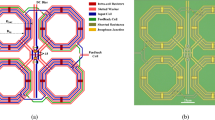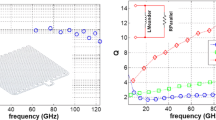Abstract
The dynamics of the dc SQUID, when voltage biased through an inductor, is computed by numerical simulation and by perturbative analytical calculation. We find that the dynamic resistance decreases from its current-biased value at low bias voltages, where the inductive series reactance no longer separates the Josephson voltage oscillation from the bias source. The flux-to-current conversion ratio, however, remains almost unaffected. This effect is sometimes important in setups, where a second SQUID is used as a readout amplifier.
Similar content being viewed by others
REFERENCES
R. Welty and J. Martinis, Two-stage integrated SQUID amplifier with series array output, IEEE Tran. Appl. Supercond. 3 (1 pt. 4), 2605 (1993).
H. Seppä, Dc-SQUID electronics based on adaptive noise cancellation and a high open-loop gain controller, in Superconducting Devices and Their Applications, H. Koch and H. Lübbig (eds.), Springer Proceedings in Physics, Vol. 64, p. 346, Springer-Verlag, Berlin (1992).
A. Ahonen, M. Hämäläinen, M. Kajola, J. Knuutila, P. Laine, O. Lounasmaa, L. Parkkonen, J. Simola, and C. Tesche, 122-channel SQUID instrument for investigating the magnetic signals from the human brain, Physica Scripta T49A, 198 (1993).
H. Seppä, M. Kiviranta, V. Virkki, L. Grönberg, J. Salonen, P. Majander, I. Suni, J. Knuutila, J. Simola, and A. Oittinen, Experiments with a un SQUID based integrated magnetometer, in Extended Abstracts of 6th International Superconductive Electronics Conferee (ISEC '97), H. Koch and S. Knappe (eds.), Physikalisch-Technische Bundesanstalt, 38116 Braunschweig, Germany. A preprint available at www.iki.fi/\(\tilde m\)sk/isec97.
K. K. Likharev, Dynamics of Josephson Junctions and Circuits, Gordon and Breach Science Publishers, New York (1986), p. 208 and references therein.
B. Chesca, Analytical theory of DC SQUIDS operating in the presence of thermal fluctuations, J. Low Temp. Phys. 112, 165 (1998).
D. E. McCumber, Effect of ac impedance on dc voltage-current characteristics of superconductor weak-link junctions, J. Appl. Phys. 39, 3113 (1968).
L. G. Aslamazov and A. I. Larkin, Josephson effect in superconducting point contacts, JETP Lett. 9, 87 (1969).
L. G. Aslamazov, A. I. Larkin, and Yu. N. Ovchinnikov, Josephson effect in superconductors separated by a normal metal, Sov. Phys. JETP 28, 171 (1969).
M. Kiviranta and H. Seppä, Noise simulation of the un SQUID, Applied Superconductivity 6, 373 (1998).
V. Polushkin, D. Glowacka, R. Hart, and J. M. Lumley, Cross-correlated dynamic resistance of a direct current superconducting quantum interference device, J. Low Temp. Phys. 118, 105 (2000).
Author information
Authors and Affiliations
Rights and permissions
About this article
Cite this article
Kiviranta, M., Seppä, H. Effect of Voltage Bias on the dc SQUID Characteristics. Journal of Low Temperature Physics 123, 127–136 (2001). https://doi.org/10.1023/A:1017549632586
Issue Date:
DOI: https://doi.org/10.1023/A:1017549632586




